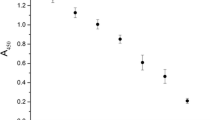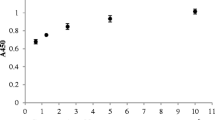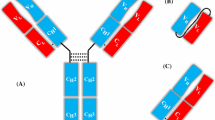Abstract
Previously, we developed an indirect competitive enzyme-linked immunosorbent assay (icELISA) for baicalin (BAL) and used this assay to investigate the pharmacokinetics of BAL in mice. In this study, an anti-BAL monoclonal antibody (MAb) was purified by the caprylic acid method and then labelled with fluorescein isothiocyanate (FITC). Subsequently, an indirect competitive fluorescence-linked immunosorbent assay (icFLISA) was developed to detect baicalin (BAL) using FITC-labelled anti-BAL MAbs. Characterization of the assay demonstrated an effective BAL measurement range of 6.4 ng/mL to 500 μg/mL (R2 = 0.997). The relative standard deviations (RSDs) for both intra-assay and inter-assay repeatability and precision were below 10 %. This icFLISA for BAL is simple, rapid and sensitive, with a 390-fold larger linear range and a 2-fold lower limit of detection (LOD) compared with the previously developed icELISA. We observed a strong correlation between the results determined by the icFLISA and icELISA methods. Overall, this study provides a useful method for detecting BAL in medicines, enabling in vivo visualization research.





Similar content being viewed by others
References
Li-Weber M (2009) New therapeutic aspects of flavones: the anticancer properties of Scutellaria and its main active constituents wogonin, baicalein and baicalin. Cancer Treat Rev 35:57–68
Jung SH, Kang KD, Ji D, Fawcett RJ, Safa R, Kamalden TA, Osborne NN (2008) The flavonoid baicalin counteracts ischemic and oxidative insults to retinal cells and lipid peroxidation to brain membranes. Neurochem Int 53:325–337
Zhao Y, Kong H, Sun Y, Feng H, Zhang Y, Su X, Qu H, Wang Q (2014) Assessment of baicalin in mouse blood by monoclonal antibody-based icELISA. Biomed Chromatogr 28:1864–1868
Kong H, Wang XQ, Wang QG, Zhao Y, Sun Y, Zhang Y, Xu JK, Qu HH (2015) Effect of puerarin on the pharmacokinetics of baicalin in (Gegen Qinlian Decoction) in mice. Chin J Integr Med. doi:10.1007/s11655-015-1973-0
Sakamoto S, Taura F, Pongkitwitoon B, Putalun W, Tsuchihashi R, Kinjo J, Tanaka H, Morimoto S (2010) Development of sensitivity-improved fluorescence-linked immunosorbent assay using a fluorescent single-domain antibody against the bioactive naphthoquinone, plumbagin. Anal Bioanal Chem 396:2955–2963
Zhao Y, Qu H, Wang X, Zhang Y, Cheng J, Zhao Y, Wang Q (2015) Development of fluorescence-linked immunosorbent assay for paeoniflorin. J Fluoresc. doi:10.1007/s10895-015-1568-3
Zhang Z, Li Y, Li P, Zhang Q, Zhang W, Hu X, Ding X (2014) Monoclonal antibody-quantum dots CdTe conjugate-based fluoroimmunoassay for the determination of aflatoxin B1 in peanuts. Food Chem 146:314–319
Sakamoto S, Tanizaki Y, Pongkitwitoon B, Tanaka H, Morimoto S (2011) A chimera of green fluorescent protein with single chain variable fragment antibody against ginsenosides for fluorescence-linked immunosorbent assay. Protein Expr Purif 77:124–130
Brodsky Y, Zhang C, Yigzaw Y, Vedantham G (2012) Caprylic acid precipitation method for impurity reduction: an alternative to conventional chromatography for monoclonal antibody purification. Biotechnol Bioeng 109:2589–2598
Saniee P, Siavoshi F, Nikbakht Broujeni G, Khormali M, Sarrafnejad A, Malekzadeh R (2013) Localization of H.pylori within the vacuole of Candida yeast by direct immunofluorescence technique. Arch Iran Med 16:705–710
Okumura N, Aosai F, Yui K, Yamashita K, Yabu K, Kanai M, Yano A (1986) Cellular FITC-linked immunospecific assay (cell-FLISA) for detection of monoclonal antibodies against cell-surface antigens. Hum Immunol 15:97–108
Su X, Qu HH, Zhao Y, Sun H, Sun Y, Wang XQ, Wang QG (2013) Establishment of quick enzyme-linked immunosorbent assay with monoclonal antibody against baicalin. Chin J Pharm Anal 06:946–949
Acknowledgments
This research was supported by the National Natural Science Foundation of China (81473338, 81373542), the National Key Basic Research Development Program (973 program, 2011CB505101) and the Classical Prescription Basic Research Team of Beijing University of Chinese Medicine. This manuscript has been thoroughly edited by a native English speaker from Elsevier Language Editing Services.
Conflict of Interest
The authors declare no conflicts of interest.
Author information
Authors and Affiliations
Corresponding author
Additional information
Wenchao Shan and Jinjun Cheng contributed equally to this work.
Rights and permissions
About this article
Cite this article
Shan, W., Cheng, J., Qu, B. et al. Development of a Fluorescence-Linked Immunosorbent Assay for Baicalin. J Fluoresc 25, 1371–1376 (2015). https://doi.org/10.1007/s10895-015-1627-9
Received:
Accepted:
Published:
Issue Date:
DOI: https://doi.org/10.1007/s10895-015-1627-9




